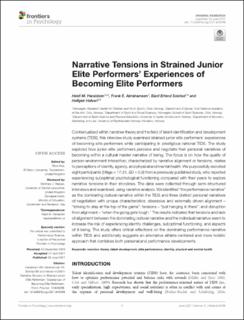| dc.contributor.author | Haraldsen, Heidi Marian | |
| dc.contributor.author | Abrahamsen, Frank Eirik | |
| dc.contributor.author | Solstad, Bård Erlend | |
| dc.contributor.author | Halvari, Halgeir | |
| dc.date.accessioned | 2021-11-08T13:09:29Z | |
| dc.date.available | 2021-11-08T13:09:29Z | |
| dc.date.created | 2021-04-21T16:46:25Z | |
| dc.date.issued | 2021 | |
| dc.identifier.citation | Frontiers in Psychology. 2021, 12(2021), Artikkel 645098. | en_US |
| dc.identifier.issn | 1664-1078 | |
| dc.identifier.uri | https://hdl.handle.net/11250/2828396 | |
| dc.description | This is an open-access article distributed under the terms of the Creative Commons Attribution License (CC BY). The use, distribution or reproduction in other forums is permitted, provided the original author(s) and the copyright owner(s) are credited and that the original publication in this journal is cited, in accordance with accepted academic practice. No use, distribution or reproduction is permitted which does not comply with these terms. | en_US |
| dc.description.abstract | Contextualized within narrative theory and the field of talent identification and development systems (TIDS), this interview study examined strained junior elite performers’ experiences of becoming elite performers while participating in prestigious national TIDS. The study explored how junior elite performers perceive and negotiate their personal narratives of becoming within a cultural master narrative of being. The focus is on how the quality of person-environment interaction, characterized by narrative alignment or tensions, relates to perceptions of identity, agency, and physical and mental health. We purposefully recruited eight participants (Mage = 17.31, SD = 0.9) from a previously published study, who reported experiencing suboptimal psychological functioning compared with their peers to explore narrative tensions in their storylines. The data were collected through semi-structured interviews and examined, using narrative analysis. We identified “the performance narrative” as the dominating cultural narrative within the TIDS and three distinct personal narratives of negotiation with unique characteristics: obsessive and externally driven alignment – “striving to stay at the top of the game”; tensions – “just hanging in there”; and disruption from alignment – “when the going gets tough.” The results indicated that tensions and lack of alignment between the dominating cultural narrative and the individual narrative seem to increase the risk of experiencing identity challenges, suboptimal functioning, and aspects of ill-being. The study offers critical reflections on the dominating performance narrative within TIDS and additionally suggests an alternative athlete-centered and more holistic approach that combines both personal and performance developments. | en_US |
| dc.language.iso | eng | en_US |
| dc.subject | elite performance | en_US |
| dc.subject | identity | en_US |
| dc.subject | narrative theory | en_US |
| dc.subject | physical and mental health | en_US |
| dc.subject | talent development | en_US |
| dc.title | Narrative tensions in strained junior elite performers’ experiences of becoming elite performers | en_US |
| dc.type | Peer reviewed | en_US |
| dc.type | Journal article | en_US |
| dc.description.version | publishedVersion | en_US |
| dc.rights.holder | © 2021 Haraldsen, Abrahamsen, Solstad and Halvari | en_US |
| dc.source.pagenumber | 13 | en_US |
| dc.source.volume | 12 | en_US |
| dc.source.journal | Frontiers in Psychology | en_US |
| dc.identifier.doi | 10.3389/fpsyg.2021.645098 | |
| dc.identifier.cristin | 1905683 | |
| dc.description.localcode | Institutt for idrett og samfunnsvitenskap / Department of Sport and Social Sciences | en_US |
| dc.source.articlenumber | 645098 | en_US |
| cristin.ispublished | true | |
| cristin.fulltext | original | |
| cristin.qualitycode | 1 | |
